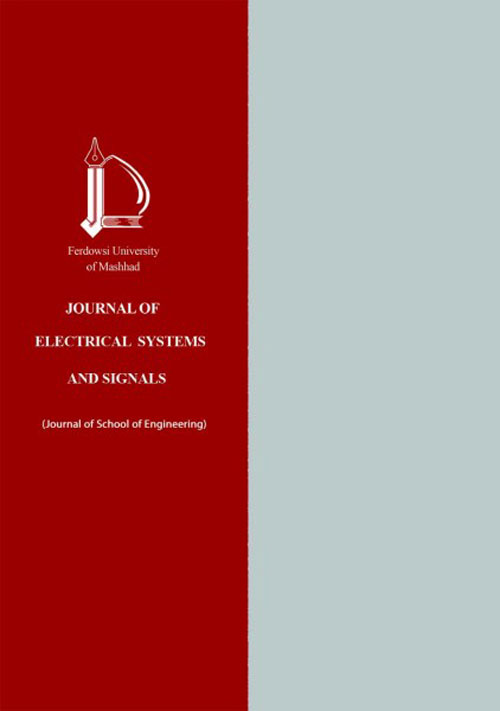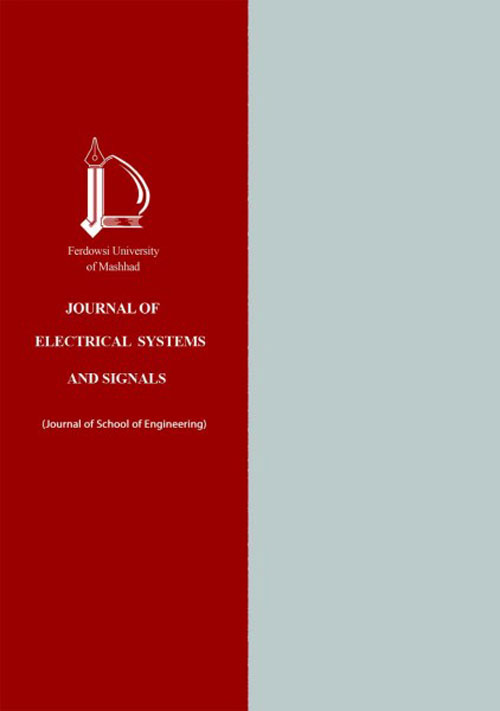فهرست مطالب

Journal of Electrical Systems and Signals
Volume:2 Issue: 2, 2014
- تاریخ انتشار: 1393/04/30
- تعداد عناوین: 6
-
A 5.3-9.3 fJ/Conversion-Step 4-32 MS/s 10 bit Asynchronous SAR ADC with Optimized DAC Timing Strategy in 0.13 μm CMOSPages 1-10In this paper, a low power SAR Analog to Digital Converter (ADC) with a resolution of 10 bits and a sampling rate of 4 to 32 MS/s is proposed. It utilizes an asynchronous process with an optimized D/A timing strategy to increase its sampling frequency. This ADC is simulated in a 130-nm CMOS technology with two power supplies of 0.6 V and 1.2 V. It achieves an ENOB greater than 9.3 bits for its full sampling-rate range (4 to 32 MS/s) with an FOM = 5.3 to 9.3 fJ/conv.-step.Keywords: Analog to digital converter, asynchronous process, power efficiency, asynchronous clock generator circuit, low power designs
-
Low-Power Level-Shifting Architecture for Sub-threshold Logic CircuitsPages 11-16This paper presents a power-efficient voltage level shifter converting low levels of input voltages (sub-threshold) to high levels of the output voltages (above threshold). In order to reduce the existing contention in the output nodes between pull-up and pull-down devices, the proposed circuit uses a current generator to reduce the strength of the pull-up device when the pull-down device is pulling down the output node. This causes the circuit to be functional even for the sub-threshold input voltages. In order to avoid the static power dissipation, this current generator turns on only during the transition times in which the logic level of the input signal is not corresponding to the output logic level. Simulation results of the proposed circuit in a 0.18-µm technology confirm that for a low supply voltage of VDDL = 0.42 V at the input and a high supply voltage of VDDH = 1.8 V at the output, the level shifter has a propagation delay of 22 ns, an energy per transition of 340 fJ, and a static power dissipation of 0.42 nW for 1-M Hz input signal.Keywords: Level shifter, level converter, sub, threshold, low power operation, dual supply
-
Design of GMR-Based Wideband Optical Reflector Using Memetic Algorithm with Fuzzy Logic Local SearchPages 17-20Wideband, GMR-based reflector is designed employing a novel variant of memetic algorithm with fuzzy logic local search. High quality, single periodic layer reflector with SOI structure is designed with reflectance >99.50% over 1.35 μm to 1.9 μm spectral band. The proposed optimization/design method is very powerful and able to optimize complex structures with desired optical responses.Keywords: Guided mode resonance, memetic algorithm, fuzzy logic, periodic structures, optical reflectors
-
Throughput Optimization in OFDMA Cognitive Radio Networks Based on Node Selection and Power AllocationPages 21-31Node selection and resource management are two key issues in cognitive radio networks. Due to channel impairments in wireless networks, cooperative spectrum sensing is used in orthogonal frequency division multiple access (OFDMA) cognitive radio networks. The problem is designed to maximize the system throughput under the constraints of power budget and detection performance. This problem is solved using convex optimization methods and the priority of nodes for participating in sensing and transmission processes and also the optimal power of transmission nodes are obtained. For implementing this solution, three algorithms are proposed. The results reveal the benefits of the proposed algorithms in terms of throughput and sensing performance.Keywords: Cognitive radio, cooperative spectrum sensing, OFDMA, throughput, power allocation
-
Image restoration with regularization convex optimization approachPages 32-36In this paper, Tikhonov regularization with l-curve parameter estimation as convex optimization problem has been proposed in image restoration as a solution of ill-posed problem stem from sparse and large scale blurring matrix which has many singular values of different orders of magnitude close to the origin. Also, since the restored image is so sensitive to initial guess (start point) of optimization algorithm, a new schema for feasible set and feasible start point has been proposed. Some numerical results show the efficiency of the proposed algorithm in comparison with previous proposed methods.Keywords: Image restoration, convex optimization, Tikhonov regularization, l, curve estimation
-
Alignment-Free Fingerprint Cryptosystem Based On Multiple Fuzzy VaultsPages 37-45It is very important to protect fingerprint templates in the fingerprint recognition systems. Fuzzy vault is a promising and applicable scheme for this purpose. It can protect biometric templates. Also it can perform secure key management. Alignment of the query fingerprint sample in the encrypted domain and the template fingerprint sample is a challenging task. In this paper, we propose an alignment-free fingerprint cryptosystem based on multiple fuzzy vaults. In the proposed method, in registration phase, multiple vaults are constructed for one fingerprint and in verification phase, if at least two of the vaults are decoded successfully by the query fingerprint, the secret will be recovered. The Experiments of the proposed fingerprint cryptosystem are conducted on FVC2002-DB1a and FVC2002-DB2a datasets to evaluate the performance of the proposed fingerprint cryptosystem.Keywords: Fingerprint, minutia, reference point, fuzzy vault


